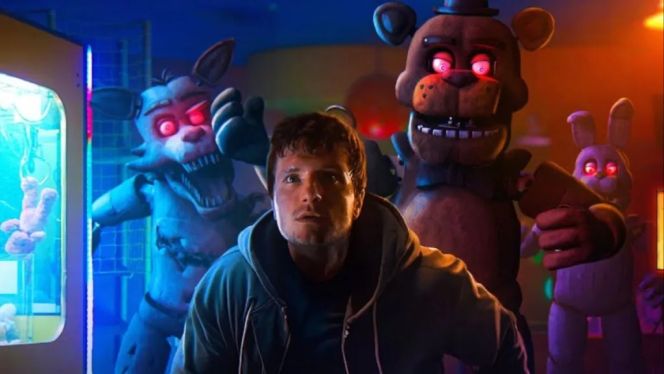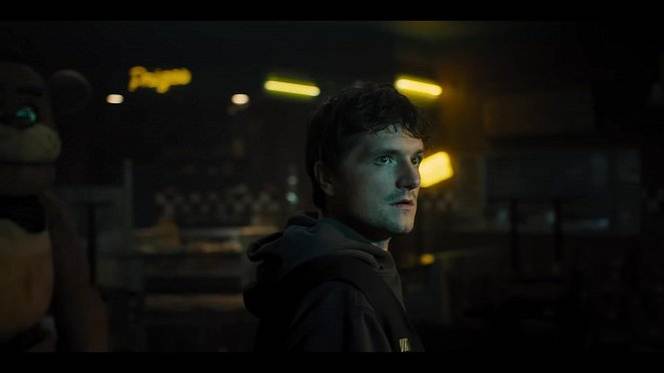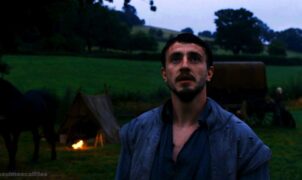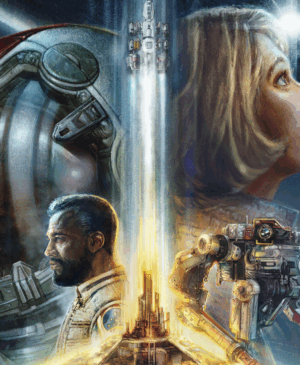PREVIEW – The terrifying horror game phenomenon becomes a blood-chilling cinematic event, as Blumhouse— the producer of M3GAN, The Black Phone and The Invisible Man— brings Five Nights at Freddy’s to the big screen.
Nearly a decade ago, game developer Scott Cawthon found himself at a crossroads. Cawthon’s previous gaming projects had not been financially successful, and he found himself in a crisis of faith, questioning whether he should give up game development entirely and find a different path. Then, late one night, Cawthon came across a review of what he had imagined might be his final gaming effort, Chipper & Sons Lumber Co. A user had written that the animatronic characters in the family-friendly game were “unintentionally terrifying.” In that moment Cawthon had an epiphany: What if he were to make something intentionally terrifying?
Five Nights at Freddy’s, the resulting horror game, puts players in the shoes of Mike, a night watchman hired to look after the abandoned theme-style Freddy Fazbear’s Pizzeria. Players quickly learn that it’s the restaurant’s derelict animatronic stage performers —Freddy Fazbear, Bonnie, Chica and Foxy the Pirate—they must worry about, because the hulking creations seem to take on a life of their own between midnight and 6 a.m.
Cawthon released the point-and-click survival game on August 8, 2014, and it was an immediate hit, topping charts and being played by some of the world’s most popular YouTubers. Sequels quickly followed and Cawthon built a global franchise that now includes nine games, spin-off games, a novel trilogy and an anthology series, each expanding and developing the film’s sinister lore into a complete narrative universe. “I’m not going to pretend to understand all of the reasons why these characters and stories have connected with people over the years,” Scott Cawthon says. “I just know that it’s my job to honor that and try not to screw it up!”
When Hollywood inevitably came calling, Cawthon was justifiably protective of his creation and wary of a film industry that didn’t exactly have a great history with game-to-film adaptations. But producer Jason Blum, founder of the undisputed global house of horror, Blumhouse, believed that it was possible to make a successful film from the beloved game franchise. “It’s a perfect project for the Blumhouse banner,” Blum says. “The games are horrifying, fun and engaging, and they have a built-in community where people of all ages across the world can come together and share in something bigger than themselves.” So, Blum reached out to Cawthon to start a conversation about what might be possible for Five Nights and Blumhouse.
“Scott and I connected about ten years ago,” Blum says. “He had attempted to develop a movie with another company, and he was at first very skeptical, but I pursued him for about a year, and initially we did a very short option on Five Nights. As we started working together and we got to know one another, we began to trust each other more. Over the course of the eight years or so that we worked on the movie, we developed a terrific partnership. I respect him, and I know he respects me. Hopefully this will be the first of many movies we make together.”
Blum succeeded, Cawthon says, because he remained faithful to the source material and respected Cawthon’s instincts. “The biggest challenge was finding the right story that people could connect with,” Cawthon says. “Jason always believed in my vision for this, and even though my pursuit of that vision ended up delaying the movie for quite some time, I’m very happy with the end result. That would have never happened without Jason Blum and his team at Blumhouse. I don’t think I will ever be able to fully express my gratitude.”
As the game’s creator, Cawthon was also the film’s oracle and unwavering advocate for the game’s loyal fans. “Scott has been amazing,” Blum says. “He is so passionate and, obviously, he’s such a great steward for the Five Nights at Freddy’s brand. He always has the fans in mind and is really tapped into the Five Nights community. He was an amazing guide for us, and a fantastic godfather for the movie.”
For both Cawthon and Blumhouse, creating a film that fans would love was the paramount ambition. “It was the number one priority to satisfy the fanbase,” Cawthon says. “Yes, it’s important to make the movie enjoyable for people unfamiliar with the franchise, but the reality is that this movie wouldn’t even be getting made if it weren’t for the people who have been there from the beginning. It’s thanks to the fans that I’m here doing this at all, and that the movie got made in the first place, so making it for them was everyone’s first priority.”
After Cawthon drafted an initial screenplay, the next step was finding the right creative captain to oversee the project. Blum suggested Emma Tammi, with whom he had recently worked on two horror anthologies and a documentary for Blumhouse TV. “I’ve known Emma Tammi for years and she’s very generous as a collaborator,” Blum says. Tammi was intrigued by the idea. “Jason called me and said they’d been developing this project, and he’d like me to talk with Scott to see if our visions for the film aligned,” Tammi says. “Scott and I connected, and I told him my instincts for the adaptation, and he said, ‘Alright, why don’t you do a pass on the script and we’ll see if it’s a fit.’”
Tammi’s ambition was to create a film that would both terrify and entertain, but also resonate. “You go to horror movies, to Blumhouse movies, to be scared,” Tammi says. “And with our protagonist Mike, the haunting of his past goes deeper than the jump scares, as he struggles with guilt and shame that he can’t reconcile. On top of that, there is incredible ambiance and tension within the setting of the pizzeria, like in the game, and a bit of humor sprinkled throughout the movie. All of this is meant to be experienced collectively. I hope the film takes audiences on a fun ride, and also an emotional journey that stays with them after the jump scares are over.”
That was the key in the lock, Cawthon says. “There were many people who took a stab at the story and weren’t really able to do anything with it because it just wasn’t a good fit,” Cawthon says. “Emma was the first person to step in and really pull everything together; it started coming alive! That’s when I knew she was right for the job.”
Tammi, Blum says, tapped into the deep well of emotion (and emotional trauma) beneath the horror. “Emma’s approach to the world of Freddy’s was really second-to-none.” Blum says. “She was able to fine-tune this story in a way that had previously been missing, bringing a heart to the story that made you more invested in the characters. She hit it off incredibly well with Scott immediately and they had a great collaboration in bringing the world to life.”
In the development process of Cawthon’s script, Tammi was joined by screenwriter Seth Cuddeback. “The world of FNAF is incredibly rich and complex,” Cuddeback says. “I went pretty far down the rabbit hole for sure. Even though this movie only really covers the first game, it was important for me to understand as much as possible about what makes the world tick. It was a blast.”
Although Tammi and Cuddeback knew that the film’s iconic animatronic characters, towering 7-feet tall, would naturally command attention, they focused their adaptation on the story’s innate humanity. “Because this is essentially a haunted-house film, the scares were never going to land unless the audience was invested in the human characters, especially Mike, our protagonist,” Tammi says. “We’re feeling the scares through him.”
Blum says that this focus elevated the stakes, both narratively and emotionally.
“The film is based on the game, but it’s also so much more,” Blum says. “It’s a story about a security guard trying to survive a horrifyingly haunted place. But the real haunting is his struggle within. He’s challenged with putting his past behind him and staying present in order to save his sister.”
Tammi also saw endless potential in the story’s central location: A once thriving, now abandoned family pizzeria-arcade. “There was a sense of nostalgia about it that felt really familiar and relatable,” Tammi says. “As fun as those places were, there was always a tinge of fear behind the smiles.” Adds Cuddeback: “I think there’s a memory many of us have of wandering into an old animatronics attraction and being inadvertently freaked out.”
With their combined efforts, Tammi and Cuddeback were able to turn around a revision of Cawthon’s script in record time, and it was met with a welcome response. “Scott really liked it, and Blumhouse was excited; we were off to the races,” Tammi says.
From then on Tammi, Cuddeback and Cawthon worked together, to further refine the script. “The priority was always to make an adaptation that fans would be really excited about,” Tammi says. “But on top of that, I was hoping to make a film that would be accessible to a general audience, too. It felt like a prime opportunity to open the world of Freddy’s up to an even wider audience, and the overall story we were crafting felt accessible to people that might not know the game.”
Adds Blum: “Fans have been clamoring for this movie for a long time and I am thrilled to finally give them what they want. The film is based on the first game, but Scott, Emma and Seth created this deeper story around the characters from the game that I think will resonate with all audiences.”
With the script completed, the filmmakers turned their focus to the critical discussion of how best to create the film’s animatronic stars. Everyone agreed there was only one creature effects house that was up to the job: Jim Henson’s Creature Shop, the iconic creators behind such cultural touchstones as Sesame Street, Dark Crystal, Teenage Mutant Ninja Turtles and Babe. “I grew up on Henson movies and TV, and I’m so impressed with how their creations always seem to have a soul,” Tammi says. “They just come to life in a way that feels really unparalleled and unique and weird and quirky, just all the things we were hoping the animatronic designs for our film would be.”
The actual process of building the characters was painstaking and labor-intensive, by design, ensuring that each creation was singular. “The craftsmanship was just incredible,” Tammi says. “I would stop by Henson’s to check in on things, and it was a sight to behold, everyone working on these designs. Certain parts were being built over here, and others were being sewn over there. Everything was done by hand. It is just this incredible workshop, which feels really special and rare these days.”
The results wowed the entire creative team. “The Jim Henson Creature Shop team is brilliant,” Blum says. “They’re so detailed and their craftsmanship takes you out of this world and throws you right into Freddy’s. There was extreme pressure in taking on a concept that is so beloved by the fans and already has visual representation. But the team was diligent and meticulous in their research and also in their collaboration with Scott. There was no better group to trust in bringing the animatronics to life.”
The animatronics proved invaluable in other ways once filming began. “The actors were able to be present and in-the-moment,” Tammi says. “They were having real-time interactions with the characters. It was huge.” It also immersed the cast and crew in a bygone era when both family restaurants and family movies where at their peak. “Our story dips into time periods when films were being made with mostly practical effects,” Tammi says. “And the animatronics from these types of entertainment pizzerias, which had their heyday in the 1980s, always felt wildly tactile and wonderfully imperfect. We wanted to pay homage to all of that.”
As the film ramped up into production, Cawthon was repeatedly reminded of why Tammi had been the ideal choice to direct Five Nights at Freddy’s. “Emma was a joy to work with on the set,” Cawthon says. “The cast and crew liked and respected her, which makes a huge difference in morale and quality of performances. I also don’t think she ever sleeps, which is great for productivity.”
Source: UIP
















Leave a Reply